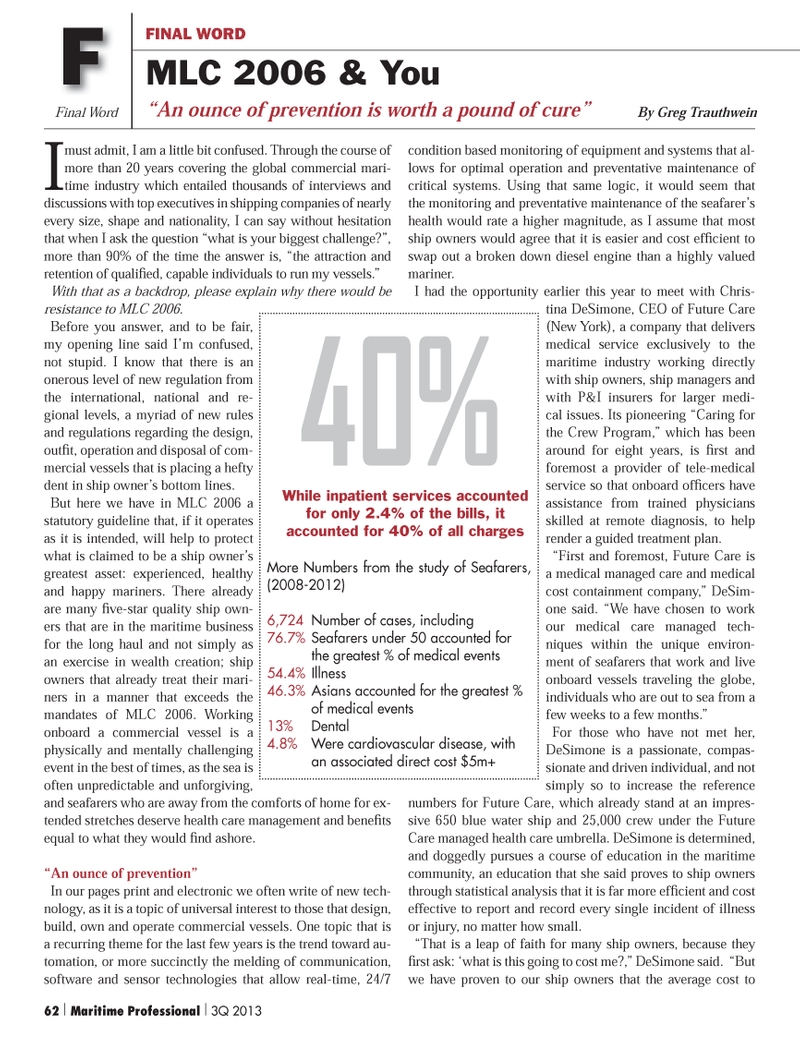
Page 62: of Maritime Logistics Professional Magazine (Q3 2013)
Training & Security
Read this page in Pdf, Flash or Html5 edition of Q3 2013 Maritime Logistics Professional Magazine
Final Word FINAL WORD MLC 2006 & You FBy Greg Trauthwein I must admit, I am a little bit confused. Through the course of more than 20 years covering the global commercial mari- time industry which entailed thousands of interviews and discussions with top executives in shipping companies of nearly every size, shape and nationality, I can say without hesitation that when I ask the question ?what is your biggest challenge??, more than 90% of the time the answer is, ?the attraction and retention of quali ed, capable individuals to run my vessels.? With that as a backdrop, please explain why there would be resistance to MLC 2006. Before you answer, and to be fair, my opening line said I?m confused, not stupid. I know that there is an onerous level of new regulation from the international, national and re-gional levels, a myriad of new rules and regulations regarding the design, out t, operation and disposal of com- mercial vessels that is placing a hefty dent in ship owner?s bottom lines. But here we have in MLC 2006 a statutory guideline that, if it operates as it is intended, will help to protect what is claimed to be a ship owner?s greatest asset: experienced, healthy and happy mariners. There already are many ve-star quality ship own- ers that are in the maritime business for the long haul and not simply as an exercise in wealth creation; ship owners that already treat their mari- ners in a manner that exceeds the mandates of MLC 2006. Working onboard a commercial vessel is a physically and mentally challenging event in the best of times, as the sea is often unpredictable and unforgiving, and seafarers who are away from the comforts of home for ex- tended stretches deserve health care management and bene ts equal to what they would nd ashore. ?An ounce of prevention? In our pages print and electronic we often write of new tech- nology, as it is a topic of universal interest to those that design, build, own and operate commercial vessels. One topic that is a recurring theme for the last few years is the trend toward au- tomation, or more succinctly the melding of communication, software and sensor technologies that allow real-time, 24/7 condition based monitoring of equipment and systems that al-lows for optimal operation and preventative maintenance of critical systems. Using that same logic, it would seem that the monitoring and preventative maintenance of the seafarer?s health would rate a higher magnitude, as I assume that most ship owners would agree that it is easier and cost ef cient to swap out a broken down diesel engine than a highly valued mariner. I had the opportunity earlier this year to meet with Chris-tina DeSimone, CEO of Future Care (New York), a company that delivers medical service exclusively to the maritime industry working directly with ship owners, ship managers and with P&I insurers for larger medi- cal issues. Its pioneering ?Caring for the Crew Program,? which has been around for eight years, is rst and foremost a provider of tele-medical service so that onboard of cers have assistance from trained physicians skilled at remote diagnosis, to help render a guided treatment plan.?First and foremost, Future Care is a medical managed care and medical cost containment company,? DeSim- one said. ?We have chosen to work our medical care managed tech-niques within the unique environ- ment of seafarers that work and live onboard vessels traveling the globe, individuals who are out to sea from a few weeks to a few months.? For those who have not met her, DeSimone is a passionate, compas-sionate and driven individual, and not simply so to increase the reference numbers for Future Care, which already stand at an impres-sive 650 blue water ship and 25,000 crew under the Future Care managed health care umbrella. DeSimone is determined, and doggedly pursues a course of education in the maritime community, an education that she said proves to ship owners through statistical analysis that it is far more ef cient and cost effective to report and record every single incident of illness or injury, no matter how small. ?That is a leap of faith for many ship owners, because they rst ask: ?what is this going to cost me?,? DeSimone said. ?But we have proven to our ship owners that the average cost to ?An ounce of prevention is worth a pound of cure? 40%While inpatient services accounted for only 2.4% of the bills, it accounted for 40% of all charges More Numbers from the study of Seafarers, (2008-2012)6,724 Number of cases, including 76.7% Seafarers under 50 accounted for the greatest % of medical events54.4% Illness46.3% Asians accounted for the greatest % of medical events13% Dental4.8% Were cardiovascular disease, with an associated direct cost $5m+62 | Maritime Professional | 3Q 2013MP #3 50-63.indd 62MP #3 50-63.indd 629/10/2013 2:47:53 PM9/10/2013 2:47:53 PM

 61
61

 63
63
